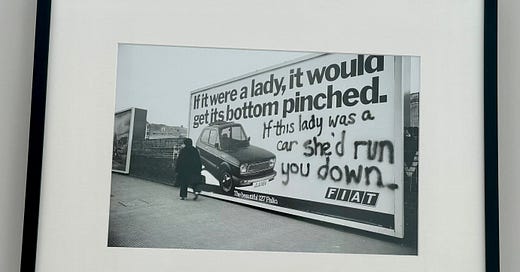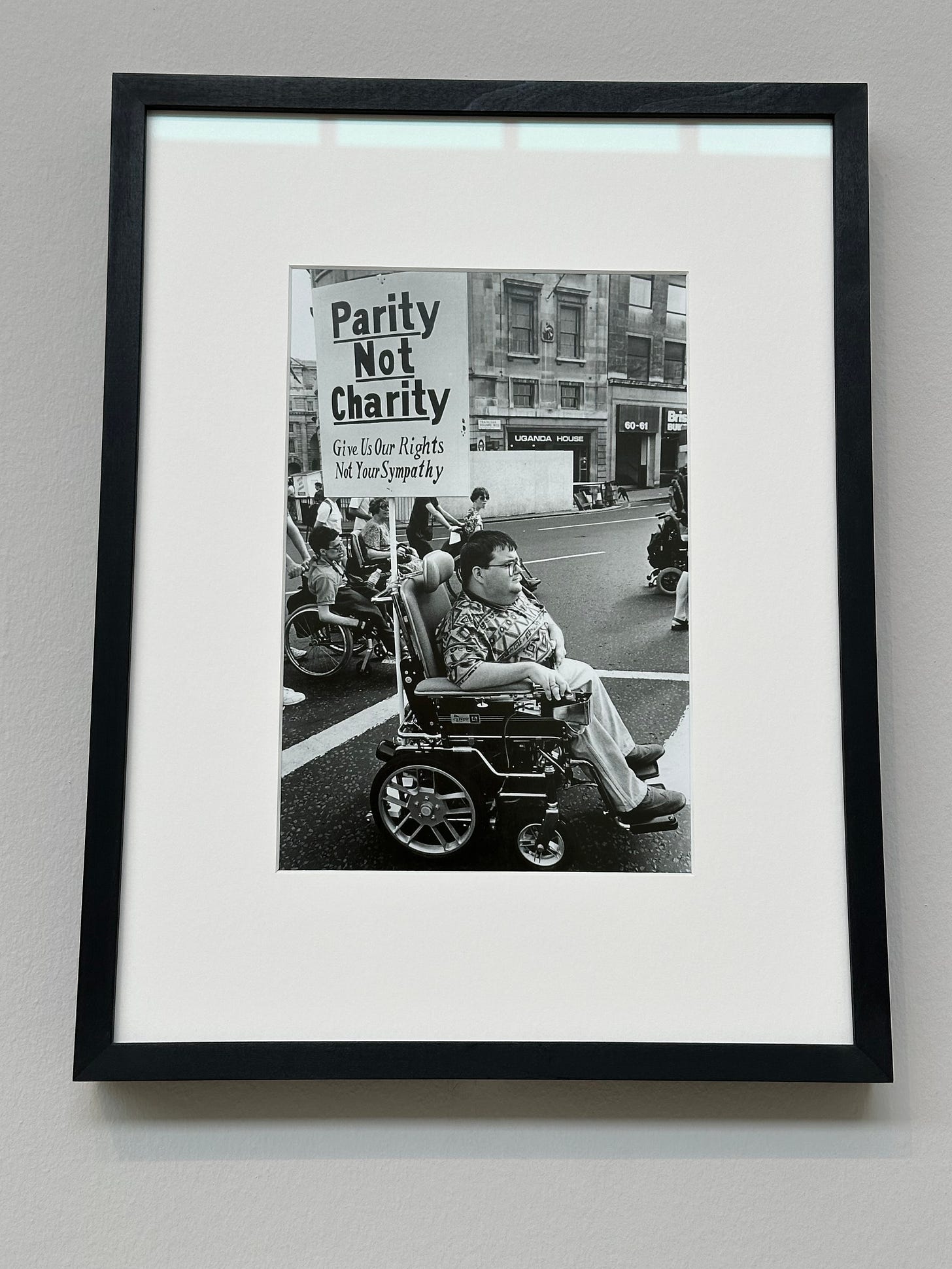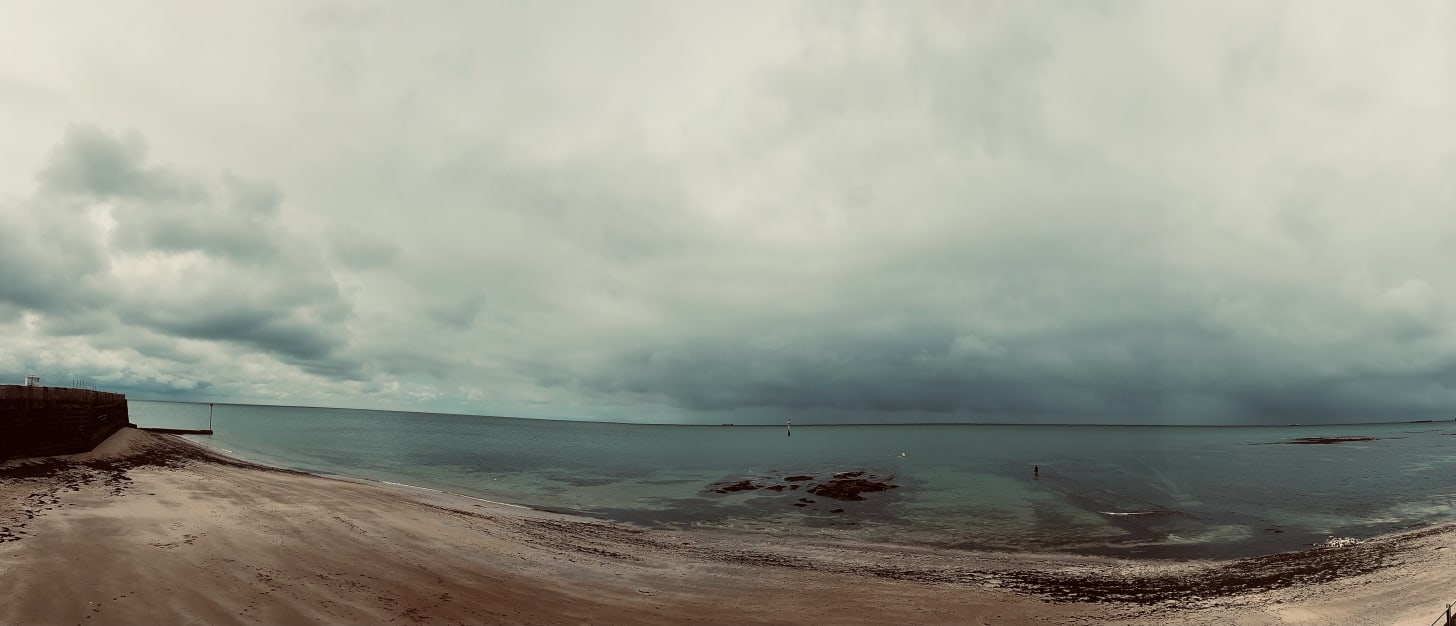The FLK Review: Turner Contemporary, Margate
The FLK takes a culture trip and learns a little more about himself
Turner Contemporary, Margate.
April 2025
This year St Georges day fell slightly after Easter. With my children being of an age where they no longer need constant supervision, I took a week's holiday after the Easter break.
A series of many mini breaks and trips were planned but when a late change to the schedule came about, think unforeseen circumstances, my wife and I were left scratching around for things to do. I watch a lot of YouTube these days, something that's made fun of in the household, but it was that forum and a documentary on my favorite artist, JMW Turner, that eventually led to a memorable day.
I had seen this ‘doc’ many years ago when it was shown on terrestrial TV, its format was a kind of docu-drama of Turner's life. But it was the introduction that got my ‘little grey cells’ working. Turner was born on 25th April. St Georges day. How perfect….How had I not known that?
A few years back, I went to the National Gallery in London. This was something I had promised myself I would do, as soon as I had the chance and as soon as it was deemed safe, after all the lock downs and social distancing measures had stopped or scrapped.
My two favorite ‘Turners’ hang side by side there (Rail, Steam and Speed 1844 and The Fighting 'Téméraire' tugged to her Last Berth to be Broken up. 1838).
Being so famous and also positioned where they are in the gallery, it can be tricky to get any longer than 10 or 20 seconds viewing time, without a head popping up in front of mine, or the camera phone trend, collecting images of images, people losing a sense of place.
I’m not being a snob here, but most who do this, completely lose their sense of direction and social boundaries when in the hurried pursuit of taking photos of paintings, rather than actually looking at them.
On this day however, the timing of the visit, pretty early in the day, had led to half an hour with these two beautiful works. Standing close, drifting back slowly, using the seats warmed up by Bond and Q some years before. I could see how the images appeared to change when viewing at different angles, how the strokes of paint could appear to suggest many different things, depending on where you viewed them from. I could see the movement and majesty, one image hurtling towards me, suggesting an excitement of what's to come juxtaposed with the other, the elegance of a last journey, the slower pace, the ship knowing what it is to become of it. The beauty of the image, it's only reward.
I was moved. The experience was moving. To have so much time with images that mean so much to me that are usually shared in a social setting. I doubt I would get this much time with them, alone, again. But this is a selfish view. The point of galleries is not only to enjoy the art, but to enjoy the art in the company of others, regardless of their motivations. That's an ‘experience’.
So with that in mind, I checked opening times and events, seeing that there was a celebration of Turner's 250th birthday, reading that this in part was being arranged by another fine artist in Tracey Emin.
So off my wife and I went, not to London and the National Gallery, but to Margate and the Turner contemporary.
Our trip to Margate was trouble free. Entering the town, the first things to notice are the long sandy beaches, to the left and the Arlington ‘TOWER’ to the right. Having lived in and grown up in London, where residential tower blocks like this were 10 a penny as a child, I’ve always struggled to see Arlington Tower with the affectionate eyes that so many do. I realise I am talking about people's homes here, but for me that brutalist style represented poverty. People ushered into high rises as their land was sold off from underneath them and communities, the one thing the poor as a whole did have an abundance of, were lost. I speak with some experience here as my London family had been settled in some of the poorest parts of London for hundreds of years, before they were moved out not to a high rise tower block such as this post war, but to the pre war council estates of the South East.
Moving past this though were the familiar facades of Dreamland, amusement arcades, beach shops, pubs and of course, fish and chip shops.
I hear often as to how Margate is becoming the latest example of gentrification in the south coast and there is evidence of that if you dig a little deeper. I can never decide if I like what I see. Do I have a deeper affection? Will I get a childhood flashback, paddling in the sea, wiping sand from my toes, or the taste of an ice cream or milkshake that I had pestered my mother for. In the past I have taken small black and white photographs with me, ones with my father in, when he was a child, before World War 2 changed everything, and tried to match where he and my grandparents stood, to where I was standing now. I wanted to look back in time.
But on other occasions, it just feels like no one cares about the place, ‘would a lick of paint’, ironic as I’m going to a gallery, ‘really hurt that much’. You can see where the rents are high and the close season hits home hardest. People's lives and livelihoods, put on hold for the hope of a return of decent weather. Shops become shells.
But there is a beauty to that as well. The sea is a constant, but never stays the same, maybe Margate is its reflection.
This day I needed my walking stick. Pain management had been a problem for a few weeks, a bigger problem than usual. I had just purchased a lightweight option, one that was adjustable. The old wooden one I had used for years and one that had accompanied me on a journey to Australia, was no longer fit for purpose, I needed something now that could reflect my differing leg length.
The disabled parking at the venue is just by a Sea wall and these spots actually feel like they have a priority point of place, not only due to its access to the building, but to its location to the sea and seascapes. The things that Turner went to Margate to paint, especially, in his later years.
I found the stairs leading to the gallery manageable. They open to a large and spacious courtyard area that must lend itself to functions of all kinds in warmer months. The paving was even and partially enveloped on two sides by glass. To my left, the cafeteria, busy and doing good trade, in front of me, large automatic doors of the main entrance.
Everything feels spacious. The glass panels to me, resemble unframed paintings, their art are the people on either side. Feelings of space and openness, assist me in taking in the new and the ideas. Locational and cognitive head space.
Once inside the exhibition was clearly marked as was the lift access. The lifts' primary function, I think, is to transport the exhibitions from one floor to another as the lifts themselves were cavernous. I almost felt guilty for using them.
What I thought was going to be an exhibition of Turner's work, was to be a solitary painting, one that he had painted when in his 60s.
Waves Breaking on a Lee Shore at Margate (Study for ‘Rockets and Blue Lights’)'.
I had another National Gallery moment here, just my wife and I present with the painting. What a treat.
Why did we feel the need to whisper in front of it? Did we think it could hear our critique and compliments? Was it because we had a personal experience with something we considered to be ‘Great Art’, was it a sign of respect. I’m not sure.
To be able to again see the thickness of Turner's paint, scratch marks, reworked ideas, up so close, was amazing. It should never feel a privilege to see art or experience it, it should be everyone's right if they want it, but I did feel privileged. I felt lucky.
Eventually leaving that space, my wife checked the website to see where I had inevitably gone wrong. Not for the first time, I had misread minor details, like what the main exhibition actually was, but today, this was a ‘Happy Little Accident’ Cheers Bob Ross.
A few years back I had taken my sons to see a photographic exhibition at the Turner Contemporary. The theme then was human rights. The photos were deeply moving and captured struggles and hope in equal measure. This had left a mark on us as a family. The exhibition today ‘Resistance’ was on a similar theme, this time photos capturing points of time in British society.
Over the next two hours, we took a stroll through time, through repression and hardship. Stark black and white images, frames and borders. The aesthetic mimicked the polarising opinions on display, possibly reflecting the differing opinion of the viewer as well. The colours of the faces, whether skin colour, or skin coloured by coal dust, of uniforms, police or army, or the uniforms of the young, jeans, t shirts, or the uniforms of the politicians or bankers, a suit and tie.
The frames and borders reflect my own journey of attitudes towards these subjects. The black frames, historical opinions that were holding me adjacent to those of the people I am now looking at, the white border my clearer head space, a place that is mature now with my own experiences and less impacted by those that guided me when younger. The images themselves, representing struggle, human experience, disjointment and hope, of political or social messages not only me but the wider society around me. So many I found difficult to take seriously or give credence to at important and significant times in our recent past. But with my own maturing mind, I have begun to see in a completely different light.
My footsteps were heavy. I felt a responsibility to take each image in, to do the subject some justice, or to pay respect. In some cases images were inspiring, some reflecting pain and suffering, just because of difference, social, or otherwise. My own indifference to these issues and peoples life experience at certain points in my life, in part, makes me feel ashamed now. I felt sorrow, that a byproduct of their suffering has been my developing enlightenment, but what fee did I pay and what part have I played, other than to hinder.
How little I know about impacts on my own social environment historically. Hunger marches across the country in the 1930s, an era my father and aunt were born into and my grandparents would have been aware of and possibly even taken part in.
The battle of cable street. A pre-war abhorrence. Incidents brewed by the sickening and willful thoughts of racism, fascism and hate. Seeing Mosley lifting his right arm in salute at post war marches, 13 years after the Cable Street incident and 3 years after a war that was fought to rid the world of the divisive and disgusting ideals of a master race.
What had a greater impact on me however were the images captured in my own lifetime. I know people that were there at the Battle of Lewisham, that stood their ground at Greenham Common, that were on duty in Durham during the Miners strikes of the 80s, that were embroiled in the Poll Tax riots, that possibly had to hide their true selves in the hysteria of the Aids epidemic in the 1980s. Images of familiar buildings in unfamiliar times. I recognise New Cross, realising I was alive during the riots in the early 80s, and the tragic fire that was the catalyst, but never feeling their impacts. It felt a world away then, rather than the 5 miles they actually were.
Piss on Pity. My personal reminder to do better when it comes to understanding the journey of a community, the Disabled community, I am a part of, has endured for so many years. That the idea of social equality over handouts and help, is not as new as I had thought, that the resistance to this was as strong and if not stronger in the 1970s, simply because ‘our’ voice wasn’t tolerated or held as important and constructive.
Tony Benn MP, doing what Tony Benn always did, putting human existence before the apparent necessity of war. Who is there in the British Government that will do this now I wonder.
Trafalgar Square, a hub of ‘Britishness’, a representation of the antiquated Empire, of representing what made Britain what it was, pomp, a bygone era. In these photos however, the space is taken over time and time again by those marginalised by that society, not by people that want to join it, but by those that need to change it. Finding comfort and a sense of togetherness in a place not built for them.
These images portrayed the struggles of people who should never have been in those positions in the first place. Who at very least deserved to be shown the respect of being heard.
People desperately searching for their place in society, but the doors being slammed shut, because you are gay, because you are coloured, because you are disabled, because you believe in a god that’s spelt differently, because you are a woman, because you care about the environment, because you don’t want us all to die in a nuclear event, because you are hungry, because you are afraid a disease we know nothing about is killing our friends and lovers.
When leaving that exhibition space, I felt weary. I was relying on my stick for more than just pain relief and balance. I stood for a moment alone, looking through a large floor to ceiling and expansive window. The view was Turner's sea. Moving, rolling, shifting the sands beneath. The sky was partially dark, almost divided in two, angry clouds to one side and the sun breaking out at the other. I was unsure if there was a storm coming or going. Maybe this was a lifescape portrait of the resistance I had spent time with.
The Turner contemporary is one of the many spaces we have in the UK, that I think we need to make more of, and more noise about. It's mostly free, some exhibitions you need to pay for, but the costs seem reasonable, if planned for. The building itself is large and spacious, it manages in some places to bring the wide horizon inside, the clean lines and colour on the walls keep things as simple as possible, helping to draw focus to the important stuff, the art. The ‘facilities’ (toilets) are well labelled, clean and human friendly, ailment free or not. The ‘gift shop’ area makes good use of its space and mostly stocks gifts and books relevant to the exhibitions on show.
There is notable room for people that may need to be accompanied by a carer or friend, for those that may need more than a walking stick to aid them as I do, I would describe the building and access to the exhibitions as wheelchair friendly. My only gripe, and this could possibly be aimed inwards, is that as mentioned, I used the stairs at the start of my experience here, this was as I couldn’t find the lifts. This could possibly be signposted a little better, but ironically, I was leaning against a wall in the courtyard when I made a note of this and a sign with directions to the lifts was above my head.
Resistance is on until the 1st June 2025
Waves Breaking on a Lee Shore at Margate (Study for ‘Rockets and Blue Lights’)'. Can be viewed until April 2026
Venue Details
Web:
https://turnercontemporary.org/
Location
Turner Contemporary
Rendezvous, Margate
Hours
Open Tue–Sun, 10am–5pm
and Bank Holiday




